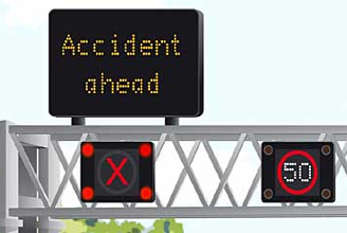Sending warning letters to drivers found ignoring RedX 'lane barred' signs on motorways has cut offender levels by 12% in a pilot scheme, it has emerged.
The seven-month trial was run by consultants Atkins and AECOM for the West Midlands Central Motorway Police Group's (CMPG) Safer Roads Partnership.
Carried out on the M6 in Staffordshire, the pilot used already available technology and processes, identifying offenders via the CMPG's existing automatic numberplate recognition network.

Red X means lane closed - don't use it
The CMPG processed the data and, following verification, issued warning letters – 30,000 over the period – to first offenders from the West Midlands and more widely as a method of soft enforcement.
'It was important', AECOM technical director, Dave Cowell told ITS(UK)'s 2015 Enforcement Conference this week, 'to have letters sent out as close as possible to the time of violation, so that the offender remembered the specific circumstances'.
The result showed offending levels falling from 5% of drivers to 4.4%.
One issue needing further study, Mr Cowell continued, is that of drivers exiting from the barred lane, seeing nothing happening on it and then moving back.
The news comes after Highways England employed so-called 'nudge' tactics - playing on behavioural insights in small scale interventions - to encourage people to drive carefully close to roadworks.
Highways England is looking at this latest study, and also showing interest in applying the system in more areas, as well as developing technologies to tackle other offences eg close following.
Trevor Hall, managing director of accident reduction consultancy Road Safety Support, later told the conference that Highways England is planning trials of close following detection systems at the Bruntingthorpe Proving Ground in Leicestershire.
The agency has already identified one supplier and is looking for a further three.